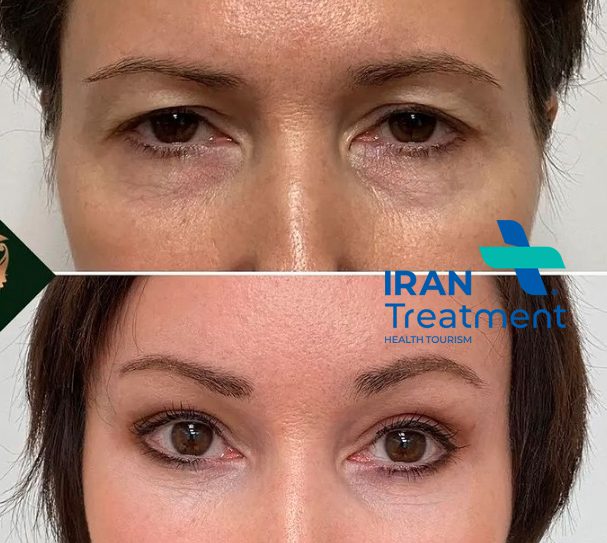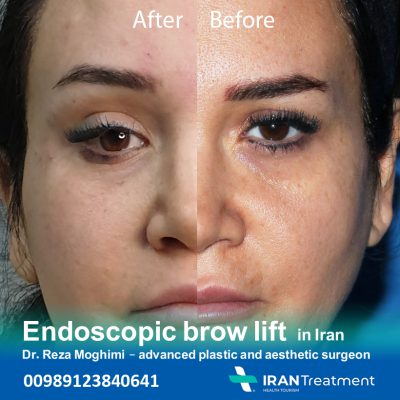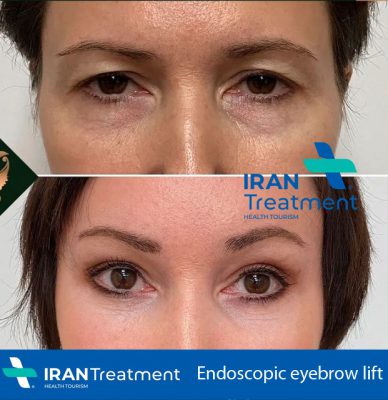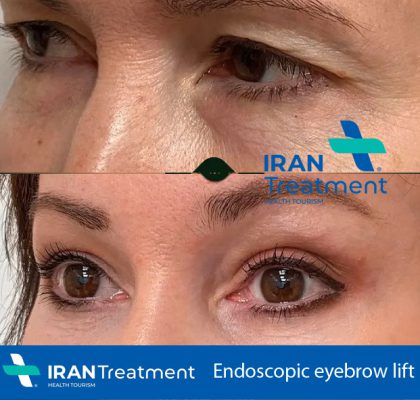Forehead lift in Iran
A Forehead lift in Iran, also known as a brow lift or browplasty, is a surgical procedure that aims to improve the appearance of the forehead, eyebrows, and upper eyelids.
The procedure is often performed to reduce the signs of aging, such as forehead wrinkles, frown lines, and sagging eyebrows. By repositioning the underlying muscles and tissues, a forehead lift can create a more youthful, refreshed appearance.
The cost of Forehead lift in Iran
| Forehead lift surgery type | Average price | Staying time |
| Endoscopic Forehead lift cost | 2000 USD | 8 days |
| Open Forehead lift | 2000 USD | 10 days |
| Limited incision lift | 1500 USD | 8 days |
| Temporal lift | 1500 USD | 8 days |
| Endotine forehead lift | 2500 USD | 9 days |
There are several techniques for performing a Forehead lift in Iran, including:
1. Endoscopic Forehead lift in Iran: This minimally invasive technique involves the use of a small camera (endoscope) and specialized instruments that are inserted through tiny incisions behind the hairline. The surgeon then lifts the forehead skin and adjusts the underlying muscles and tissues to improve the appearance of the forehead and eyebrows.
2. Open Forehead lift in Iran: Also known as a coronal lift, this technique involves making a long incision across the top of the head, from ear to ear. The forehead skin is then lifted, and the underlying muscles and tissues are adjusted as needed. Excess skin may be removed before the incision is closed.
3. Limited incision lift: This technique is a combination of the endoscopic and open methods. It involves making small incisions at the temples and sometimes along the hairline. The surgeon then lifts the skin and adjusts the underlying muscles and tissues. This technique may be suitable for patients with mild to moderate forehead sagging.
4. Temporal lift: This technique focuses on the outer portion of the eyebrows and involves making small incisions in the hairline near the temples. The surgeon then lifts and repositions the skin to create a more youthful appearance.
Recovery from a forehead lift typically takes about 10-14 days, although it can vary depending on the individual and the technique used. Swelling, bruising, and temporary numbness are common side effects, which usually subside within a few weeks. Most people can return to work and daily activities after about 2 weeks, although strenuous physical activities should be avoided for at least 4-6 weeks.
It’s important to have realistic expectations about the results of a Forehead lift in Iran, as the procedure can’t stop the natural aging process. However, it can create a more youthful and refreshed appearance that lasts for several years. To maintain the results, some patients may choose to undergo additional non-surgical treatments, such as Botox injections or dermal fillers.
As with any surgical procedure, a forehead lift carries some risks, including infection, bleeding, scarring, and anesthesia complications. It’s essential to discuss these risks with your surgeon and choose a qualified, experienced professional to minimize the likelihood of complications.
Endoscopic Forehead lift in Iran
An endoscopic Forehead lift in Iran, also known as an endoscopic brow lift, is a minimally invasive surgical procedure designed to reduce the appearance of wrinkles, furrows, and sagging skin on the forehead and brow area.
This procedure can help create a more youthful and alert appearance by raising the eyebrows and smoothing out the forehead.
The endoscopic technique involves the use of an endoscope, a thin tube with a camera and light on the end, which allows the surgeon to view the underlying tissues and muscles without making large incisions. This approach results in less scarring, a faster recovery, and fewer complications compared to traditional open surgery methods.
Procedure
1. Anesthesia: The patient is given either general anesthesia or intravenous sedation to ensure comfort during the procedure.
2. Incisions: The surgeon makes several small incisions in the hairline, which will be hidden by the hair after healing.
3. Endoscope insertion: The endoscope is inserted through the incisions, allowing the surgeon to visualize the underlying tissues and muscles.
4. Tissue and muscle adjustment: The surgeon carefully adjusts the tissues and muscles, lifting the brow and smoothing out the forehead. This may include removing excess skin, if necessary.
5. Closure: The incisions are closed with sutures, clips, or adhesives.
Recovery
After an endoscopic Forehead lift in Iran, patients typically experience mild to moderate swelling and bruising, which usually subsides within one to two weeks. Pain and discomfort can be managed with prescribed pain medications.
Patients are usually able to return to work and resume normal activities within 1 to 2 weeks following the procedure, although strenuous activities and heavy lifting should be avoided for at least 4 to 6 weeks.
Risks and Complications
As with any surgical procedure, there are risks associated with an endoscopic Forehead lift in Iran, including:
- Infection
- Bleeding
- Anesthesia complications
- Scarring
- Nerve injury, leading to facial weakness or numbness
- Asymmetry or unfavorable cosmetic results
- Need for revision surgery
It is essential to discuss the potential risks and complications with your surgeon before undergoing an endoscopic forehead lift. Choosing a qualified, experienced surgeon can help minimize these risks.
Open Forehead lift in Iran
An open forehead lift, or brow lift, is a surgical procedure to lift the forehead skin and eyebrows. It is often done to reverse the effects of aging and restore a more youthful appearance to the upper face. In an open forehead lift, the surgeon makes an incision across the top of the forehead, usually behind the hairline.
This allows the surgeon to lift and reposition the muscles and tissues that cause frown lines and sagging eyebrows. The incision is usually made along the natural lines and folds of the forehead for camouflage and minimal scarring.
The open forehead lift procedure typically takes 2-3 hours and is often done under general anesthesia.
The key steps in an open Forehead lift in Iran include:
1. Making an incision across the top of the forehead, behind the hairline. This exposes the forehead muscles and tissues.
2. Lifting and repositioning the forehead muscles that cause frown lines between the eyebrows. This can smooth out frown lines and raise the inner eyebrows.
3. Lifting and tightening the forehead skin. The forehead skin is lifted, trimmed, and stitched at the incision site. This elevates the eyebrows and smooths out transverse forehead wrinkles.
4. Addressing the crow’s feet area (outer eye wrinkles). The surgeon may perform additional procedures to lift and smooth the skin at the outer corners of the eyes.
5. Closing the incision with sutures. The incision is stitched and bandaged. Stitches are usually removed within 7 to 14 days.
6. Seeking follow-up care. Swelling and bruising are common after a forehead lift. Cold compresses, elevation of the head, and prescribed medications can help minimize discomfort. Most people can return to work within 7 to 14 days. Final results may take several months to become apparent as swelling fully resolves.
The open forehead lift provides dramatic results with a high degree of control and precision. However, the visible incision site may be a concern for some patients.
Alternative procedures with smaller incisions include endoscopic forehead lifts and non-surgical options like Botox injections. The best technique depends on a patient’s needs, priorities, degree of skin sagging, and personal preferences.
Limited incision lift
A limited incision brow lift, also known as an endoscopic brow lift, is a minimally invasive surgical procedure to lift and reposition the eyebrows. Compared to the open brow lift technique, the limited incision brow lift requires smaller incisions and less manipulation of forehead tissues. It uses an endoscope, a slender tube with a tiny camera, to allow the surgeon to view and access the forehead tissues that need to be lifted.
The key steps in a limited incision brow lift include:
1. Making three to five small incisions in the scalp, each about half an inch in length. The incisions are made in areas of the scalp that allow the surgeon to reach different layers of forehead tissues.
2. Inserting an endoscope through one of the incisions. The endoscope provides visualization on a video monitor to help guide the surgeon.
3. Lifting and repositioning the forehead muscles and tissues that have sagged with age. The surgeon can release and lift targeted areas of the forehead through the small incisions.
4. Optional removal of excess skin and fat. In some cases, limited trimming and contouring of forehead skin and tissues may be performed.
5. Securing the lifted tissues in place. The repositioned forehead tissues are secured using small screws, permanent sutures, or temporary fixation devices. These supports hold the tissues in their new lifted position as initial healing occurs. They typically remain for 6-8 weeks.
6. Closing the incisions. The incisions are closed with sutures and usually heal with minimal scarring. Stitches are removed within 7 to 10 days.
7. Following up and recovery. Swelling and bruising are common and treated similarly as in an open brow lift. Results may take 3-6 months to be fully realized. The small incisions typically heal with nearly invisible scars concealed within the hair.
The limited incision brow lift provides a shorter surgery and recovery time versus an open brow lift. It is best suited for patients with limited forehead sagging and excess skin, as it provides a more targeted lift with smaller adjustments. For more comprehensive rejuvenation, the open brow lift may yield better results. The optimal technique depends on a patient’s needs and aesthetic goals.
Temporal lift in Iran
A temporal lift, or temporal brow lift, is a surgical procedure focused on lifting and tightening the outer brow area, including the temporal region and crow’s feet. It is a more limited procedure than a traditional brow lift which lifts the entire eyebrow and forehead. A temporal lift provides rejuvenation for patients who want to specifically address signs of aging in the temporal area and outer eyebrows, such as:
• Sagging or drooping outer eyebrows
• Crow’s feet: wrinkles radiating from the outer corners of the eyes
• Temporal hooding: excess skin and soft tissue overlying the temporal bone
The key steps in a temporal lift include:
1. Making small incisions in the temporal area, usually within the hairline and extending into the crow’s feet region. Incisions are typically 3 to 5 inches in length for each side.
2. Dissecting and lifting the skin, muscles and soft tissues of the temporal and crow’s feet area through the incisions. The surgeon lifts and repositions sagging tissues to restore a more youthful contour.
3. Trimming excess skin. The surgeon may trim limited amounts of excess skin before redraping the remaining skin over the newly contoured temporal area.
4. Suspending and securing the lifted tissues. The repositioned tissues are secured using sutures, tissue adhesives or fixation devices. These supports hold the temporal area in its new lifted position during initial healing.
5. Closing the incisions. Incisions are closed with sutures and/or tissue adhesives. Sutures are usually removed within 7 to 10 days.
6. Recovery and follow-up. Swelling, bruising and discomfort are typically milder than with a full brow lift. Results become apparent over the first 2 to 3 months. Most people can return to normal activities within 7 to 14 days.
The temporal lift provides subtle but rejuvenating results for the outer brow and crow’s feet. It has a quicker recovery time than a full brow lift. However, it does not lift the entire brow, so it may not fully address significant brow sagging or forehead wrinkles. For some patients, combining a temporal lift with other procedures such as a brow lift, blepharoplasty or facelift may yield optimal rejuvenation of the upper face.
How long is the recovery period for Forehead lift in Iran ?
The recovery period for a forehead lift typically lasts 2 to 3 weeks. Here is a general timeline for forehead lift recovery:
• Week 1 (Days 1-7): There is swelling, bruising, and discomfort during the first week. The patient needs to keep their head elevated and apply cold compresses to reduce swelling. Pain medications and antibiotics may be prescribed by the surgeon. Most patients can return to light activities around 5-7 days after the procedure.
• Week 2 (Days 8-14): The bruising and swelling continue to subside. Stitches or staples may be removed around 1 week after the surgery. Patients can return to most normal activities but should avoid intense exercise and physical activity.
• Week 3 (Days 15-21): Most swelling and bruising should resolve by the end of the 3rd week. Patients typically feel well enough to return to work and normal social activities. However, some swelling and lumpiness along the incision lines can persist for weeks or months.
• 4-6 weeks: Patients can resume exercise and more strenuous activities. By this time, most of the residual swelling and signs of having had surgery fade away. The forehead region starts to have a smooth, natural and rejuvenated appearance.
• Several months: The forehead skin continues to adjust to the new muscle and soft tissue positioning. The incision lines continue to fade and the results become more natural-looking. The outcomes of the Forehead lift in Iran procedure are essentially permanent, although normal aging will continue.
In summary, most Forehead lift in Iran patients recover over 2 to 3 weeks but it can take several months for all swelling to resolve and incision lines to fade. Close follow-up with the plastic surgeon during this time period is important to monitor proper healing and a good outcome.
Candidates for a Forehead lift in Iran may include people who:
1. Have moderate to severe forehead wrinkles and frown lines.
2. Experience sagging or drooping eyebrows, which can create a tired or aged appearance.
3. Have asymmetry in their eyebrows or forehead due to aging, injury, or a congenital condition.
4. Are in good overall health and do not have any medical conditions that could increase the risk of complications during surgery.
5. Have realistic expectations about the outcome of the surgery and understand that while it can improve the appearance of the forehead and brow area, it may not completely eliminate all signs of aging.
6. Are non-smokers or are willing to quit smoking before and after the surgery, as smoking can impede the healing process and increase the risk of complications.
7. Are willing to follow the surgeon’s pre- and post-operative care instructions to ensure a successful outcome and minimize the risk of complications.
It’s essential to discuss your goals and concerns with a board-certified plastic surgeon during a consultation. They can help determine if you’re a good candidate for a Forehead lift in Iran and recommend the most suitable surgical approach for your unique needs.






